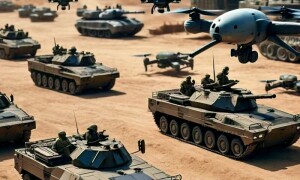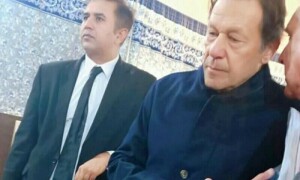At 12 am on the intervening night of 13 and 14 August, 1947, Urdu broadcaster of Radio Pakistan, Mustafa Ali Hamdani announced to the world “the dawn of independence.”
“My father told me everyone’s hearts were pounding. It was an extremely emotional moment that they were about to announce the birth of a new country,” recalls writer and poet Agha Salman Baqir in his conversation with The Citizens Archive of Pakistan (CAP) in 2017, about the role of his late father Agha Mohammed Baqir in translating the Urdu transmission made by what was then the All-India Radio, Lahore.
But this isn’t the only story we have recorded at CAP.
Conceived in 2007, CAP had one key purpose: to preserve the national memory of South Asian history.
In 2018, this idea was further realised with the inauguration of the National History Museum (NHM) in Lahore, where much of what had been collected by CAP in a little over a decade since its birth, found a permanent home.
In celebration of the five-year anniversary of the National History Museum In Lahore, the people behind it chronicle the journey to its establishment
Informed by the oral histories in its archive, NHM was curated as a space where peoples’ history, personal stories, struggles and achievements of Pakistan’s first citizens informed the narrative arch of exhibitions.
Through stories like the one Agha Salman Baqir shared, history comes to life at NHM — creating an intimate portrait of Partition and captivating visitors with a vibrant tapestry of narratives that transcend the confines of textbooks.
National History Museum, Lahore July 1, 2023 marked the five-year anniversary of NHM.
A public-private partnership, the project came about after CAP won a public bid and spent two years collecting data, producing exhibitions and executing the lofty task of presenting Pakistan’s rich heritage and culture in just 21,000 square feet.
The museum continues to be curated and managed by CAP and is a project of the Government of Punjab and the Parks and Horticulture Authority, Lahore.
NHM is located in the Greater Iqbal Park, a few yards away from Minar-i-Pakistan, a prominent landmark of our nation. Locals commonly know this area by the name of Yadgaar, meaning ‘memorial’, owing to the presence of this historic minar, which commemorates the famous Pakistan Resolution of 1940.
The museum opened its doors to the public on July 1, 2018, becoming Pakistan’s foremost digital and interactive museum. A digitally interactive museum — at the heart of the city’s historical vicinity — opens a window for people to relive significant moments in the nation’s collective memory.
As the name suggests, the National History Museum was envisioned to become a public space that familiarises people with Pakistan’s journey as a nation. It was designed to be a space for exploration, education and enjoyment, where individuals could engage with their past on a personal level and critically reflect upon it.
To this date, the museum has hosted more than 360,000 visitors, including 74,000 students. Moreover, the museum curates a roster of diverse programming, based on the content in its exhibitions, for public awareness purposes.
So far, NHM has hosted more than 120 events to engage varied audiences. The programmes include public exhibitions on the Partition, conversations on the journey of this nation and student-based competitions that promote the celebration of memories of our shared past.
THE POWER OF ORAL HISTORY
But what inspired us to venture into storytelling?
Many people in South Asia have grown up listening to stories told by their elders, often bequeathed to them by their ancestors. Yet, when it comes to the inception of Pakistan, there are little to no repositories that tap into the collective experiences of those who survived the Partition.
CAP seeks to archive such stories and offer it to a wider audience.
At the very foundation of the storytelling at NHM lies our Oral History Project. When we started collecting oral histories from the generation of Partition survivors, we recognised the urgency of documenting a generation that was slowly passing on.
We initiated the ‘ripple effect methodology’, starting with interviews of elders — parents, grandparents, aunts and uncles — who had witnessed the trauma of Partition. Then, the project expanded its research pool by tapping into the networks of the first-generation Partition survivors in Pakistan, slowly expanding into neighbourhoods, streets and cities that underwent significant transformations following the Partition.
The oral history interviews of the Partition generation reveal a very different truth from that which is commonly believed. For instance, some stories dispel conventionally held ideas of the so-called decades of animosity that existed between different religious communities in pre-Partition India.
The survivors note that it was common to find elders who had cordial and often friendly relationships across ethnic, religious and social lines. Children from different communities played together in the neighbourhoods, went to school side by side and enjoyed different religious festivities. In undivided India, co-existence was not only possible but also profitable.
Oral histories and their power are relatively new to Pakistan. In many instances, the exhibitions hosted at the museum have sparked inter-border conversations.
In 2015, the lived experience of Shafiq A Mian, and his recollection of the experience at the fringes of the newly demarcated borders of now independent Pakistan and India, started the conversation on the future of the Greater Iqbal Park.
In 2022, the museum partnered with the peace-building initiative Project Dastaan to install an exhibition that displayed three individual stories of Ishar Das Arora, Musarrat Abrar and Kamala Devi, who were displaced at the time of the Partition and had to wait all their life to revisit their childhood homes.
By introducing stories of individuals who survived the Partition and more importantly, by displaying their experiences, the museum has been able to generate novelty in the experience it offers its visitors and a point of relatability that continues across time.
VISION FOR THE FUTURE OF HISTORY
The vision for NHM has always been to enhance the art of storytelling.
Exhibitions on the Constitution of the Islamic Republic of Pakistan and the contributions of notable writers, poets and philosophers have been curated with the understanding that, as the nation’s archive collection expands, so will the outreach and dissemination of people’s history through various displays at NHM.
The team responsible for curating the National History Museum has predominantly comprised women. Inclusivity is one of our guiding principles and we ensure the representation of different ethnic, religious and gender groups in our shared history.
The museum gives voice to the contributions of these groups, which are often overshadowed in the vast historical documentation. Their personal stories of resilience, sacrifice, hardship, and, above all, hope in humanity and faith in each other are what make the National History Museum a powerful tool to teach, inspire, and connect individuals and communities.
The hope is that NHM can be a beacon of historical consciousness, inviting individuals to connect with their roots, explore the tapestry of our shared history and gain insights that shape their understanding of Pakistan’s past.
As we look back on these five years of captivating storytelling and intellectual curiosity, we celebrate the museum’s profound impact on the nation’s collective memory and its role in fostering a sense of national pride.
May it continue to be a seat of knowledge, inspiration, and connection for generations to come.
The Citizens Archive of Pakistan is a non-profit organisation dedicated to cultural preservation. @citizensarchive on twitter and Instagram. Aaliyah Tayyebi was Content Lead for NHM in 2018; Awais Malik is Director of NHM; Noor Ahmed currently heads CAP.
Published in Dawn, EOS, August 13th, 2023















































Dear visitor, the comments section is undergoing an overhaul and will return soon.